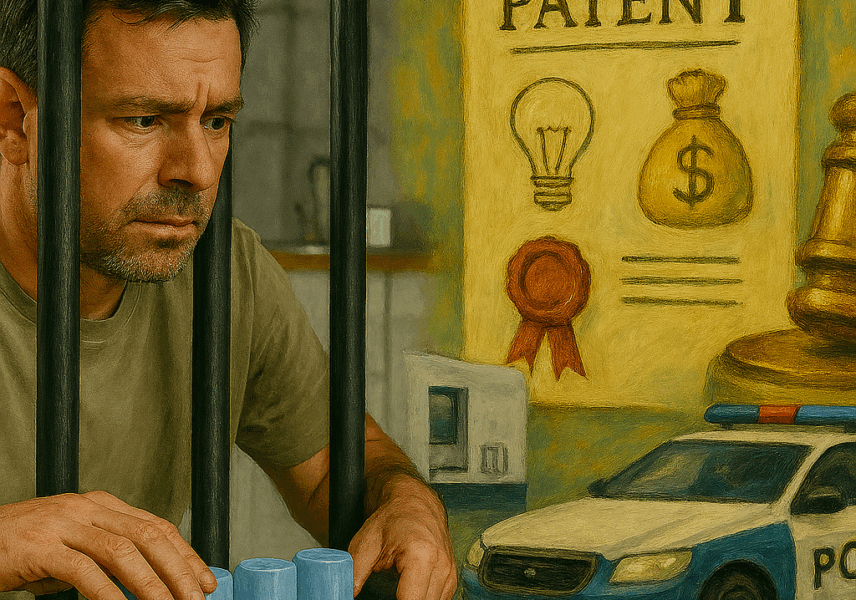
Criminal Law in Patent Infringement: The Relationship Between Imprisonment and Compensation ⚖️
The Shadows of Innovation 🌑
Let’s be honest: we’ve all dreamed of turning a brilliant idea into reality 🚀.
But what if one day someone else uses that idea without permission? This is where “patent infringement” steps onto the stage. And it’s not just a matter of “losing some money.” Things get heavier, because both criminal law (imprisonment) and civil law (compensation) come into play.
In this post, I’ll walk you through the two faces of patent infringement: one is criminal law with the threat of imprisonment, the other is civil law with compensation claims. And by the end, you’ll see that these are like two links in the same chain 🔗.
1) What Does Patent Infringement Mean?
If you own an invention and have obtained a patent under the Industrial Property Law, you have exclusive rights over it. This means: no one can manufacture, use, sell, or import your invention without your consent.
But if someone ignores this and uses it anyway, patent infringement occurs. At this point, both civil law and criminal law come into play:
- In civil law: You can file a claim for compensation (both material and moral).
- In criminal law: The infringer may face imprisonment or judicial fines.
2) The Criminal Law Dimension: Is Jail Time Real?
Yes, absolutely! 😮
According to Article 30 of the Turkish Industrial Property Law, those who infringe on patent or utility model rights can face 1 to 3 years of imprisonment and judicial fines up to 20,000 days.
So, if someone copies your patented invention and puts it on the market, they won’t just pay money—they may also lose their freedom.
👉 Courts tend to apply imprisonment more strictly in cases of intentional infringement, since it’s not negligence but a conscious violation of rights.
3) The Compensation Dimension: Who Covers Your Losses? 💸
A criminal case determines guilt, but it doesn’t fully compensate the victim’s loss. That’s where compensation lawsuits step in.
As a patent holder, you can demand compensation in the following categories:
- Actual damages: The profits lost from sales or production.
- Lost profits: The earnings you would have made if the infringement hadn’t happened.
- Moral damages: Harm to reputation or brand value.
Courts usually rely on expert reports to calculate these amounts.
4) The Relationship Between Imprisonment and Compensation ⚖️
Here’s the critical question: how are imprisonment and compensation related?
- A criminal case and a compensation case are independent of each other, but their results can influence one another.
- Even if the infringer is sentenced to prison, they are still obliged to compensate the victim.
- Paying compensation doesn’t eliminate the criminal case; it may only affect how the court exercises discretion in sentencing.
In short: both freedom and money are at risk.
5) A Table to Clarify 📊
| Dimension | Criminal Law | Civil Law (Compensation) |
|---|---|---|
| Purpose | Protect public order | Compensate the victim’s losses |
| Sanction | Imprisonment + judicial fines | Material + moral compensation |
| Who Decides? | Criminal courts | Civil courts |
| Relationship | Crime proven, damages still payable | Paying damages doesn’t erase the crime |
6) A Real-Life Example: The Small Workshop Story
A friend of mine owned a small workshop and patented a special machine part he had developed. One day, he realized a large company was producing the same part.
The result? He filed both a compensation lawsuit and a criminal complaint. The company had to pay substantial damages, and a criminal case was also initiated against those responsible.
This showed me something important: a patent isn’t just a piece of paper; behind it lies a legal force that can even lead to loss of freedom.
7) Diagram: How the Process Works
[Patent Infringement]
↓
[Criminal Case] → (Imprisonment / Judicial Fine)
↓
[Civil Case] → (Material + Moral Compensation)
Conclusion: Double Shield, Double Risk 🛡️
Dear reader, as you can see, patent infringement isn’t just a “pay some royalties and move on” issue.
- With criminal law, your freedom is at stake.
- With civil law, heavy financial liability arises.
As an inventor or entrepreneur, protecting your patent isn’t just a commercial need—it’s a legal necessity. And infringing on someone else’s patent can lead you both to the prison gates and to hefty compensation bills.
Remember: the path of innovation runs through fair competition. Ideas are valuable when they’re original, and rights are powerful when they’re protected. 🌟
